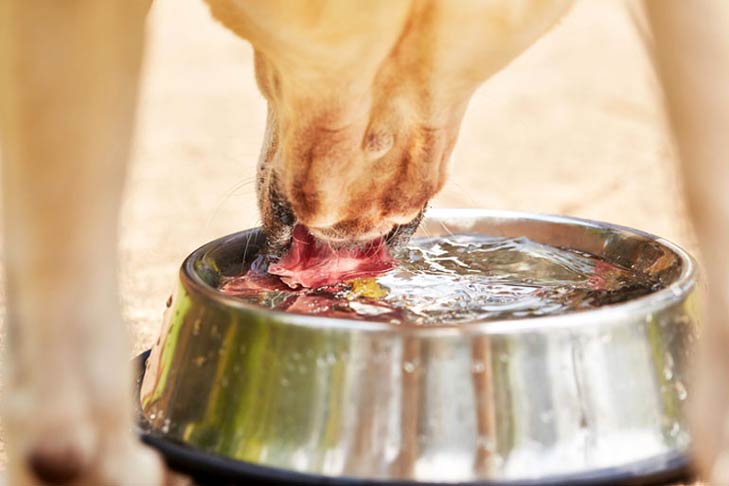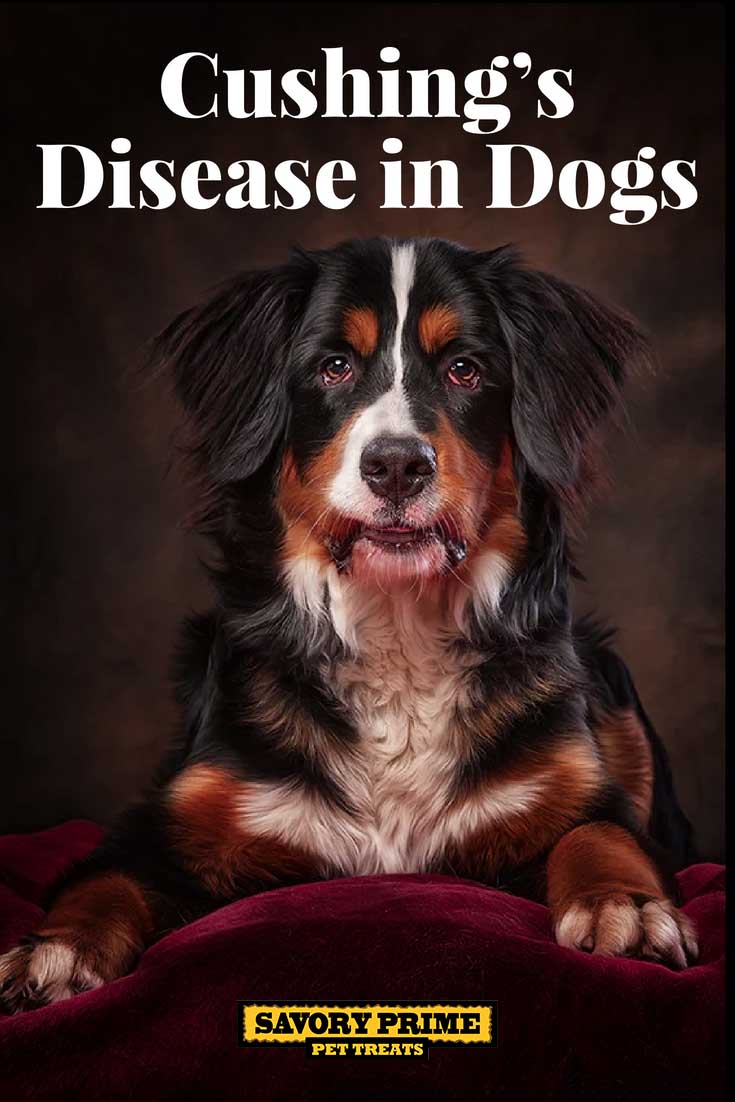If your older dog is drinking and urinating more than usual, it could be caused by a variety of reasons. One cause your veterinarian may test for is Cushing’s disease (CD), also known as hyperadrenocorticism. This condition, usually caused by a tumor in the pituitary gland, is far more common than we realize, but because of the complex diagnostic testing required, it’s underdiagnosed. Treatment is expensive and ongoing, and it requires consistent monitoring.
You may have heard of the stress hormone cortisol and the associated “fight or flight” response. Cortisol is controlled by the adrenal cortex, located on the outer layer of adrenal glands. These two peanut-sized glands, situated in front of the kidneys, produce hormones to help the body perform essential functions.
The pituitary gland, a tiny gland found at the base of the brain, releases adrenocorticotrophic hormone (ACTH), which in turn tells the adrenal glands to release cortisol, also called glucocorticoids. In a pet with CD, a tumor in the pituitary gland or, less commonly, in one of the adrenal glands, causes the cortex to release an excess amount of cortisol.
Symptoms of Cushing’s Disease
Often owners report that their first clue that something might have been wrong was their dog wanting to go out at night to urinate. The disease causes extreme thirst, so a dog with CD tends to drink tremendous amounts of water and urinate frequently. As the disease progresses, dogs lose muscle and become weak. Owners might notice a thinning of the skin, lesions on the skin, and hair loss on the flanks, neck, and perineum. Obesity and lack of energy are also symptoms.
Because it takes time — at least one year — for these symptoms to develop, and because the symptoms are often mistaken for common signs of aging, many dogs have the advanced form of CD before the owner even recognizes a problem exists.
Causes of Cushing’s Disease
Cushing’s disease is a naturally occurring syndrome, but it can also be caused by administering excessive amounts of prednisone or dexamethasone for prolonged periods. Chronic application of steroid-containing ear drops can also cause the condition because the medication is absorbed through the skin. Affected dogs develop symptoms that are identical to those of the tumor-based disease. This form resolves once the steroids are stopped.
Certain breeds are at a higher risk of developing CD. The Poodle, Dachshund, Boston Terrier, Boxer, and Beagle are some breeds to watch. Almost all patients are older than eight years when CD develops.
Diagnosis of Cushing’s Disease
Diagnosing CD is not easy and can be quite expensive. When a veterinarian suspects this disease, blood and urine tests are needed to make the diagnosis. Dilute urine and an elevation of the liver enzyme alkaline phosphatase in the blood indicate that testing for CD may be necessary.
Cushing’s disease can be verified with an adrenocorticotropic hormone (ACTH) stimulation test. For this test, a blood sample is drawn from the patient, then he is given an injection of ACTH, and a second blood test is taken a few hours later. If the dog’s cortisol level goes up a little, his adrenal response is normal. If it starts high and climbs even higher, a diagnosis of CD is confirmed.
The veterinarian may also use a second method, the dexamethasone suppression test, in which the dog receives an injection of the steroid dexamethasone. In a healthy dog, the cortisol level goes down over the following few hours because the steroid suppresses adrenal production. If the cortisol level fails to drop, it suggests there is a tumor not responding to the medication.
Ultrasound examinations also allow the veterinarian to determine whether or not a tumor is present, and if it’s located in the pituitary gland or the adrenal glands.
Treatment of Cushing’s Disease
The location of the tumor dictates which treatment to use. More than 90 percent of dogs with CD have a pituitary-gland tumor. This type of tumor is only millimeters in size and is often benign, but it’s problematic because it manufactures and releases uncontrolled quantities of ACTH, which, as explained above, stimulates the adrenal cortex to release excessive amounts of cortisol.
Though pituitary tumors are routinely removed in people, this surgical technique is still in its infancy in dogs. We treat most dogs with pituitary-based CD with medication. Mitotane (Lysodren) and trilostane (Vetoryl) are oral medications that selectively destroy part of the adrenal cortex so that although the pituitary gland tumor continues to release ACTH, cortisol levels remain normal. Careful monitoring is required to ensure that the drugs don’t destroy all of the cortex and that the cortisol stays at a defined level.
Adrenal-based CD, which thankfully is the rare form of the disease, is more concerning and best treated with surgery. About one-half of these tumors are malignant, growing aggressively and metastasizing quickly. Surgical excision of a malignant adrenal tumor is unlikely to be curative. If it is a benign growth, surgery may cure it, but the surgery is a complicated procedure.
Once treatment has been initiated, the symptoms of CD should begin to dissipate, starting with a decrease in drinking in one week or so. It takes a little longer (several months) for the skin lesions to resolve.
Prognosis for Dogs With Cushing’s Disease
The average survival time for a dog with CD is about two years, with only 10 percent of patients living beyond the four-year mark. This statistic, however, does not mean that this disease causes death. Because CD is most often diagnosed in geriatric dogs, most die of unrelated causes brought on by aging.
Recent Pet Posts
Blog Categories
Product categories
- Accessories (7)
- Chicken & Veggie Wraps (8)
- Grillers Jerky Tenders (4)
- Jerky Treats (10)
- Made in the USA (9)
- Non-Rawhide Treats (28)
- Beggar Bone (11)
- Bully Sticks (4)
- Butcher Bone (4)
- Cod Skin Fish Treats (3)
- Pork Skin Twists (2)
- Pressed Rawhide Bones & Rolls (16)
- Bones & Rolls (6)
- Pressed Rawhide Bulk (6)
- Twist Sticks (4)
- Savory Munchies (13)
- Supreme Bones & Rolls (48)
- American Rawhide Bulk (16)
- Rawhide Bones (14)
- Rawhide Chips (6)
- Rawhide Rolls & Sticks (12)
- Uncategorized (8)





